AeroPress is one of my favorite coffee brewing methods, and even though AeroPress coffee is not espresso, is one of the best espresso alternatives, so I had to write a brewing guide for it.
In this guide, we not only teach you how to make AeroPress coffee. We also give you the technical knowledge to tweak your own recipe. What works for some, doesn't work for others. So experiment and find what works best for you!
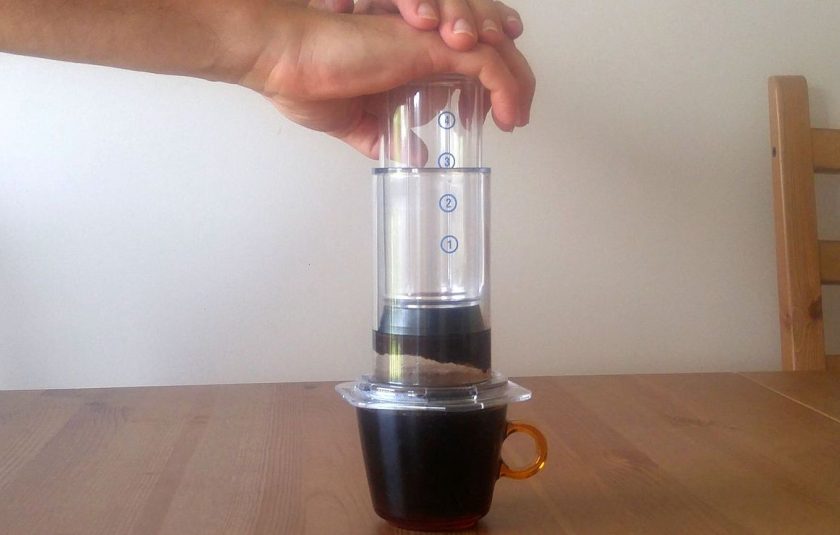
I like rich coffee (espresso is my absolute favorite), so AeroPress is a logical second place on my list. In fact, many people who like rich full-bodied coffee prefer it to espresso. You will see that my recipe is tweaked to maximize coffee richness and body.
What Makes the AeroPress Great
People new to it always ask: “What's so special about the AeroPress?” There are a few things that contribute to its fame and popularity. First of all, AeroPress is an inexpensive coffee maker. With a cost around 30$, is probably one of the least expensive coffee brewers on the market. Your grinder will cost you more than that.
Coffee enthusiasts love it because of its cleaner cup and milder taste, at the same time having a rich and complex taste. AeroPress is a milder version of espresso if brewed correctly. Some drip coffee lovers enjoy the stronger coffee made with the AeroPress, but the bolder flavor of espresso is too much for them.
Probably, the greatest advantage of the AeroPress is its versatility, and this is why is so popular among baristas. Using AeroPress is a constant surprise, you can always brew a totally different cup, yet equally great.
AeroPress is very easy to use and clean. When you are done brewing, just twist to remove the cap, discard the spent coffee puck, and rinse it.
People want to brew espresso with AeroPress; you can't get an espresso out of it, just to be clear about this. You can get a cup closer to a Moka pot coffee, though. However, as a manual brewing method, you can tweak your final cup in many ways. Stick with me and you'll find your favorite way of using the AeroPress.
Using AeroPress will give you what comes very close to an espresso… However, you will not be able to create your most favorite popular espresso based beverages that you find at coffee shops.
And since we mentioned the confusion about AeroPress and espresso, let's take a brief look at that.
AeroPress vs Espresso vs French Press
Before diving into the recipes and the technical stuff, let's see how AeroPress compares to espresso.
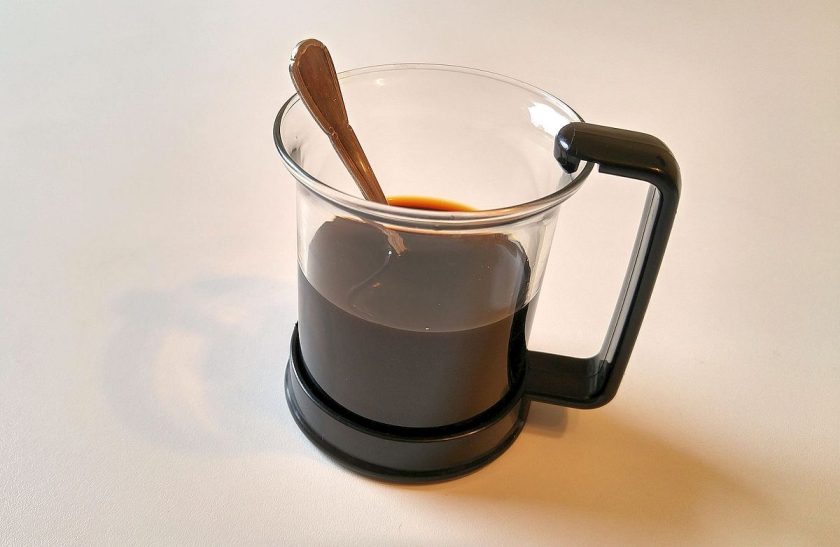
There is always a little confusion about AeroPress because the brewing concept is so similar to French press. While the two brewing methods look similar at first glance, there are a few things that make AeroPress superior to French press coffee. Not getting into it in this article, but you can read more about it here.
Another misconception about AeroPress is that it can brew espresso. AeroPress is a great espresso alternative, and technically can be called an espresso maker since it uses pressure during extraction. The drink you get from the AeroPress is a concentrated coffee, and for many that's as close as it gets to an espresso. However, it does not make the same coffee as a pump operated espresso machine.
The main difference between espresso and AeroPress is the pressure during brewing. While espresso machines can create 9 bars of pressure, we can only generate about 1 bar of pressure with the AeroPress. The high pressure is what gives the espresso the extra sharpness. The extra pressure allow the extraction of more compounds, which in turn contribute to the unique flavor profile.
The other difference is that AeroPress uses immersion and pressure for extraction. The initial immersion phase allows for a better saturation of the grinds, which increases extraction.
Why People Love AeroPress
The forgiveness of the AeroPress as a brewing method is less discussed, but I think it's important to mention. Even great baristas can pull a bad shot from time to time. The AeroPress coffee, on the other hand, is very consistent. If you follow the recipe, you'll get the same taste every single time. There is more margin for error. You can brew a decent cup even if you don't follow the recipe. Coffee tastes decently even if you screw up.
The easy cleaning is another advantage. Spent Coffee grounds are easy to discard. When you finish brewing, you push the puck of spent grounds into the trash and rinse the press.
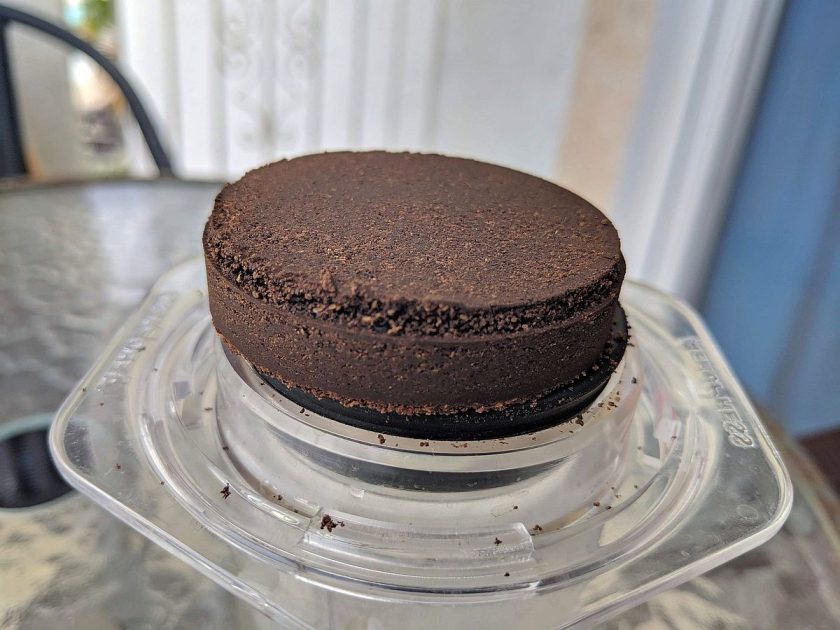
AeroPress doesn't cost much to start brewing. If you prefer bolder coffee, and you like your coffee espresso style, a metallic filter is all you need. You don't even need the paper filters that AeroPress recommends. But even if you like your coffee brighter, the paper filters are not expensive at all.
I have seen people making cold brew coffee with the AeroPress, and it's a great convenient way to do it. I personally don't like the idea, because you are blocking your AeroPress with cold brew, and you only make 7-8 oz of coffee.
Lastly, AeroPress is a great travel companion. You can take it with you in your trips, and don't rely on hotel coffee for your smooth transition into your mornings. It's easy to carry, because of it small footprint, and it's almost weightless.
Technical Details about AeroPress Brewing
AeroPress uses immersion for the extraction. Immersion optimizes the extraction compared to drip, by extracting at a uniform temperature.
By using immersion we extend the extraction time, and this allows a better saturation.
The pressure is very low, and this is the only aspect where it loses points, compared to espresso. However, it compensates some by during the steeping phase.
The lower brew temperature allows longer steeping without extracting bitter compounds. You can still brew at higher temperatures, if you want stronger flavors.
It is the device that is closest to an espresso maker. It can generate a bit more pressure, compared to a Moka pot, the other espresso alternative.
Espresso Style AeroPress Recipe
My personal recipe is a stronger cup, and I usually dilute it into an Americano. This cup has a higher TDS, with a fuller body, and a very rich taste. This is why many people would probably find it too strong. If you are an espresso lover, and you want to try AeroPress, this is a great recipe to try. If you are a drip coffee lover, this cup might disappoint you, if you don't dilute it with some hot water. Here is the recipe:
- Use a metal disc AeroPress filter, as they allow coffee oils to pass through into your coffee. This, in turn, will produce a bolder cup, closer to an espresso.
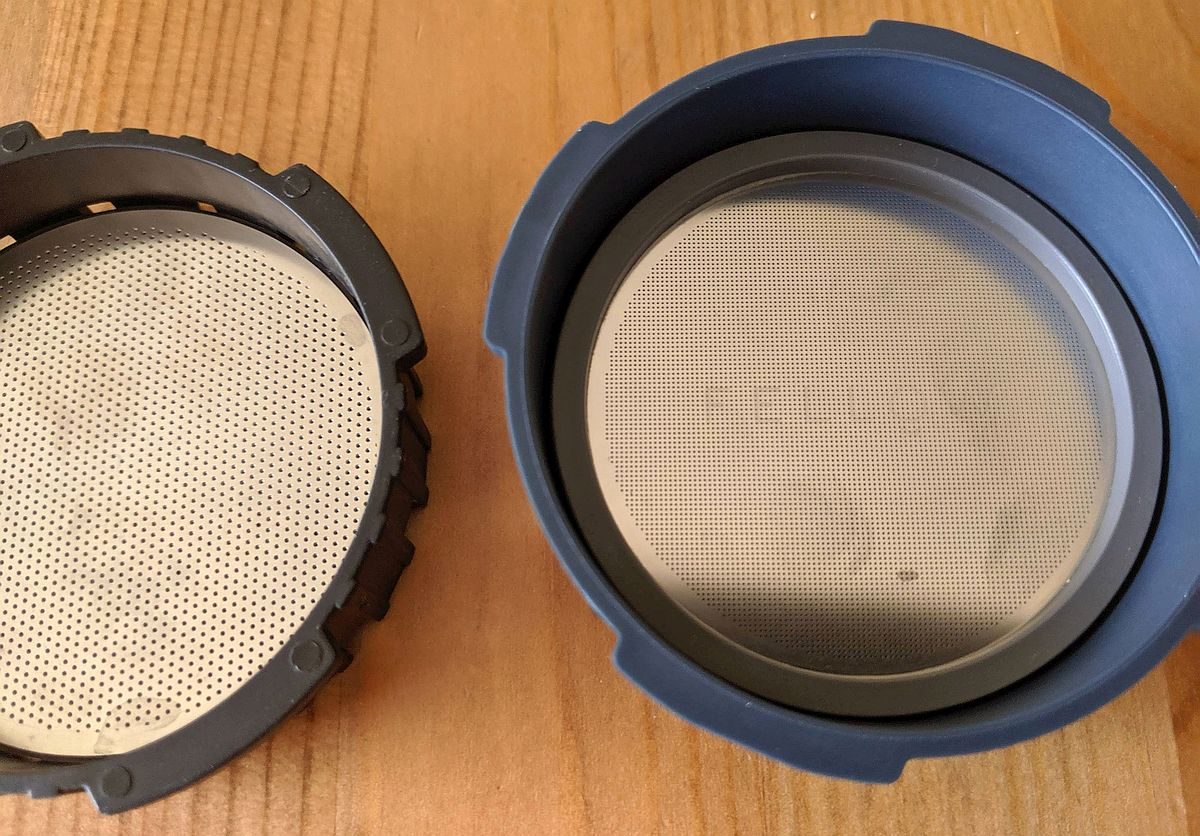
- Measure 15g of coffee on a kitchen scale. You can adjust the amount of grounds according to your taste. 3 grams up or down are totally acceptable, according to your preference.
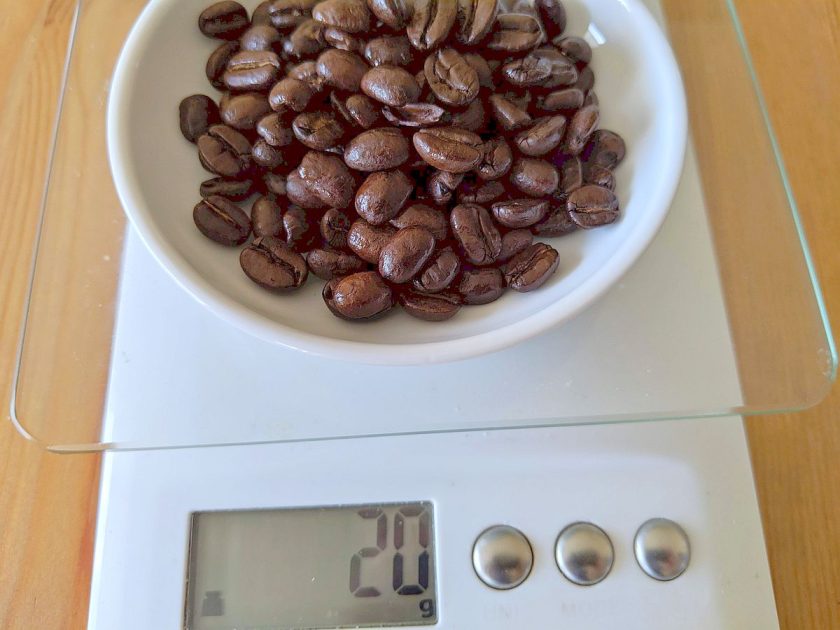
- Grind the coffee to a coarse espresso, slightly finer than for filter coffee. You will need a perfect grinder for this recipe, or a set of coffee sifters, to make sure your coffee grind is perfectly uniform.

- Turn the AeroPress upside down, with the plunger seal only slightly inserted. Make sure though to seal the beaker.
- Dump the coffee grounds in the press.
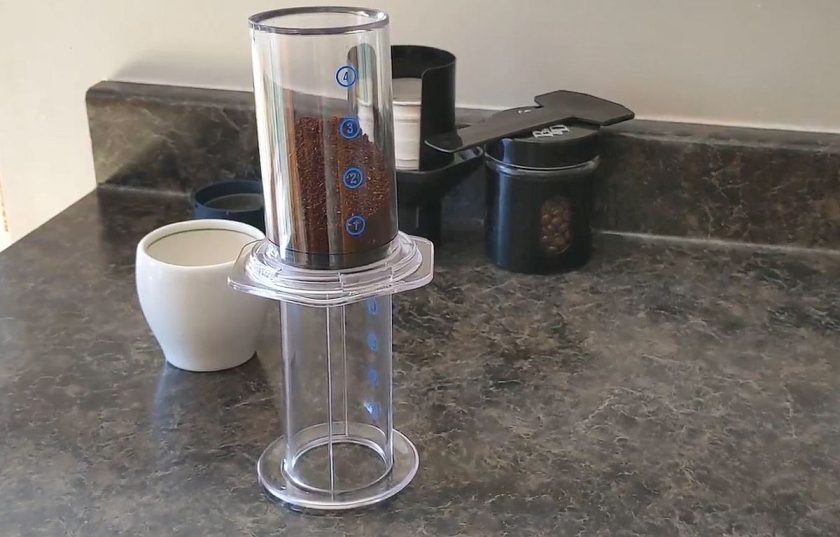
- Add 60g of water, to bloom the grounds, (that's about 2 oz or ¼ cup).
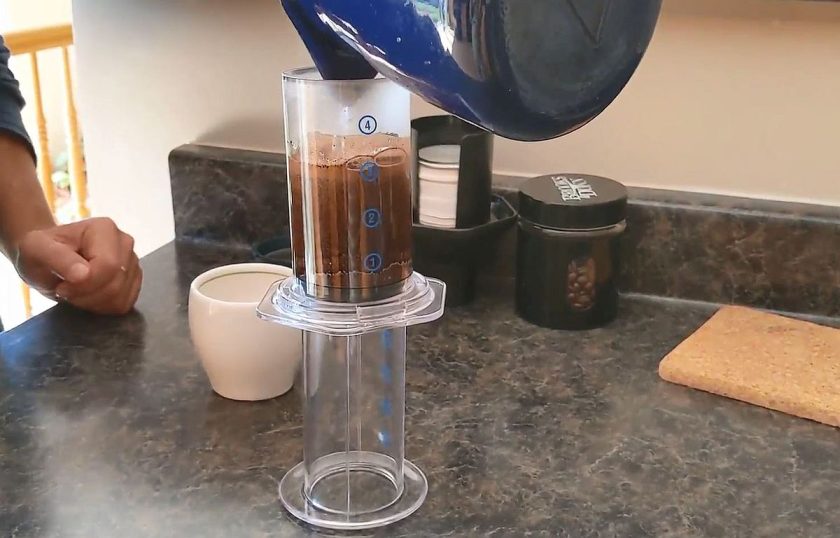
- Let it bloom for 15 seconds, and stir with a wooden stick in the meantime. Stirring ensures perfect grounds saturation, for a complete extraction. Note the lower blooming time compared to the WAC 2014 winner recipe, (next recipe).

- Pour the rest of the water fast. Aim for a 3 seconds pouring time. Note the short pouring time.
- Put the filter and the cap on, and let it steep for 60 seconds.

- Press the plunger slowly, aim for a 20 to 25 seconds press. This will bring your total extraction time to around 90 seconds.
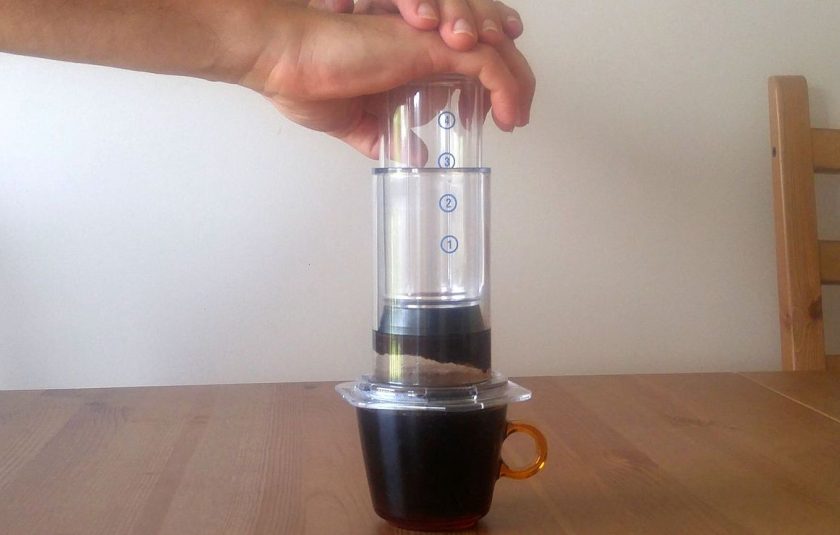
- Pour in cups, and enjoy.
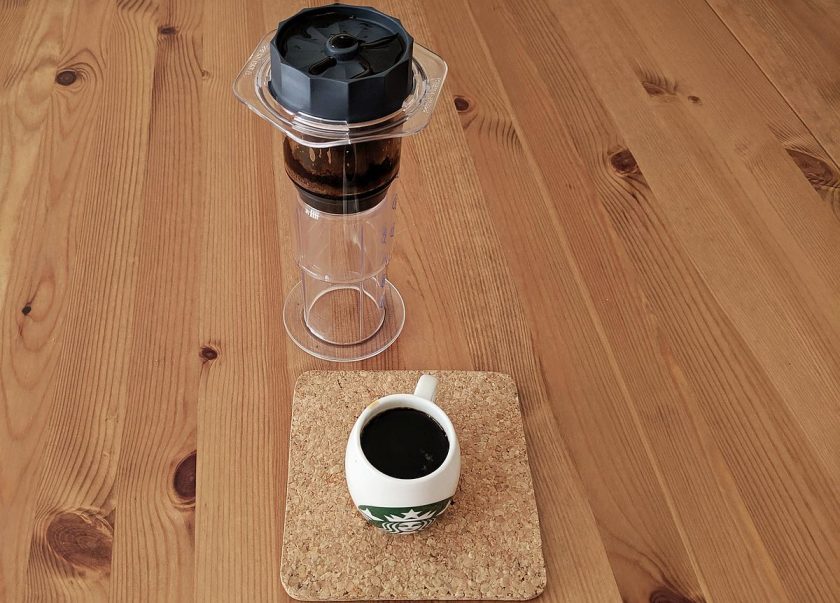
Technical Notes: The short pouring time, combined with the short blooming time, will maintain a higher brewing temperature than the WAC winner. We aim to maintain the brewing bed as close as possible to the 180 °F, where we get some of the bite associated with espresso. The finer grind and the reusable metal filter will also increase the TDS, and provide some more bite to the final cup, but it won't render it bitter.
You will have a little less volume for your brew, because the plunger takes some of the space in the beaker. However, if you find the coffee too strong, just dilute it with some hot water. Ad the water little by little, and taste it each time until you find the sweet spot. Writ down this total coffee volume and use it next time you brew.
AeroPress Brew Guide – World AeroPress Championship Recipe – 2014
My own recipe for AeroPress is my preferred method. It took me a while to perfect, and it's exactly how I want it. However, as I always say, coffee taste is subjective, so I figured I'd give you a renown recipe, one that has an International recognition.
The recipe we present today is the winner of the World AeroPress Championship 2014, and it put its creator, Shuichi Sasaki on the first place of the podium. Here are the details:
- Heat up water around 175 °F, (no hotter than 180 °F). A variable temperature kettle is very useful, but a regular kettle and a thermometer should be good enough.
- Measure 16-17g of coffee on a kitchen scale.
- Grind the coffee beans slightly coarser than for filter coffee, (grind size is a medium-coarse, less coarse than French press).
- Rinse a paper filter, and place it in the filter holder.
- Screw in the filter holder into place, and place the AeroPress on a fitting mug, and the mug on the kitchen scale.
- Dump the ground coffee in the AeroPress, and turn on the kitchen scale. It should show zero grams.
- Add 50g of water pouring slowly over the coffee bed, to bloom the grounds. That's about 1 and ½ oz.
- Let it bloom about 30 seconds, if needed stir with a wooden spoon, or stick. This ensures perfect grounds saturation, for a complete extraction. The easiest is if you paddle in a back and forth motion.
- Add the rest of the water slowly, aiming to sink as much grounds as possible. Aim for a 20 seconds pouring time. You should be able to pour another 250g of water.
- Take the mug and the AeroPress from the scale and insert the plunger in place.
- Press the plunge very slowly, aim for a 40 seconds press. This should bring your total extraction to around 90 seconds.
- Pour in cups, and enjoy.
If you need more ideas on brewing your AeroPress cup, check the World AeroPress Championship website. They published the recipes of all the former winners of the famous contest.
How to Make AeroPress Coffee – WAC 2016 Recipe [Video]
AeroPress Brewing Tips
AeroPress Brew Methods Regular vs Inverted Method
Whatever recipe you are using, you can brew it regularly, as described in the AeroPress manual, or use the inverted method.
The regular method starts with the filter and the screw cap on. You dump your coffee in, pour water, insert the plunger and press. The problem with this method is that coffee can leak through the filter before the steeping cycle is complete. With metal disk filters, the leaking is even more likely to happen.
The inverted method starts with the filter and screw cap off, and with the plunger slightly inserted, just enough to seal the beaker. The brewer stands on the plunger; you dump your coffee, pour water, place the filter and screw on the cap. Flip the brewer, and the press. This way we avoid the leakage, and we give the grounds time to expand. After coffee particles fully expand, they won't pass through the filter anymore.
The Perfect Grind size for AeroPress

I said it before, and I repeat it: “AeroPress is on of the most versatile coffee brewing methods.” You adjust a few brewing variables and you get a totally distinct cup. This is the reason that grind size for AeroPress can vary a lot. It can vary from fine grind – espresso style, to medium coarse – Chemex style. Yes – that coarse… It all depends on the recipe, that means the other brewing variables.
When it comes to grind size for AeroPress, the best thing you can do is to experiment a lot with a recipe. Pick a recipe that you think you would like, and tweak it to your taste. The next best thing is to stick to the recipe. Don't change a recipe if you are not prepared for at least a dozen of failed attempts.
As a general rule, if the grind size is coarser, you need hotter water, otherwise you risk getting an under-extracted cup, that translates into sour coffee.
Water Temperature
Many people can't get out of the hot coffee routine, and they use hot water with their AeroPress. Yes, AeroPress coffee is slightly colder than drip. Firstly because of the low brew temperature, and secondly because of the small volume that allows a faster cooling. Resist the urge to use hotter water. Coffee will taste much better if you use the temperatures recommended in the recipes. Typically, the water temperature for AeroPress is between 175 °F and 185 °F.
With darker roasts could use colder brewing temperatures, since they are more soluble. Light roasts on the other hand, can use higher water temperature for brewing.
But there are a lot of recipes using higher water temperatures. These recipes adjust down the the immersion time, and the result is a coffee that tastes a lot like American coffee. If you don't follow the recipe and you use incorrect brewing parameters, the hot water will make your coffee bitter.
Again, the proverbial AeroPress versatility… And don't forget, we can even use it to cold brew.
How Much Coffee to Use?
Using the AeroPress scoop is probably the easiest way to measure your beans amount. On Aerobie.com you will find out that a heaping scoop can hold 14 grams of coffee. In fact, depending on the roast level, and origin, coffee can vary a lot in density. So you can have a few grams difference between light roasted beans and dark roasted ones. The best way is to weigh your beans at least when you first use them. You can use the scoop, but use a scale at least the first time you use a particular blend or bean. After the initial volumetric calibration, you can use scoop based measurements.
The amount of coffee used depends on your taste, and the way you drink your coffee. This can be anywhere between 12 grams and 18 grams, but most people prefer to brew around 15-17 grams.
How Much Coffee Does AeroPress Make?
You can get about 8 fluid ounces of coffee with the inverted method, and just under 10 fl oz with the regular brewing method. Mind you, in order to get the 9.7 fluid ounces of coffee, you need to be very precise when you place the piston in the brew chamber. The plunger takes some space in the beaker, when inserted.
If you think that there is not enough coffee for the trouble, remember, this is strong coffee, espresso strength. This means you can make about two cups of coffee, after diluting it with some hot water.
AeroPress Brew Time
The 1 ½ minutes steep time might seem like too long. The concern is over-extraction. However, the low brewing temperature will prevent over-extraction.
AeroPress is similar to French press from this perspective. Long steeping times are perfectly acceptable, when you lower the brewing temperature.
On the other hand, if you stop brewing too early, you might get an under-extracted cup. The 90 seconds total extraction time is a good rough estimate. You can play with it, maintaining everything else the same, and experiment. I personally tend to extend the brewing time over the 90 seconds. The water cools down anyway, and the risk of over-extraction decreases.
AeroPress Filter

The filter choice comes down to preference, at the end of the day. If you like a clear cup, or you want to filter out coffee oils, the choice is the stock paper filter. If you want a cup that resembles more to espresso, get the metal filter. Firstly, it will get you a fuller bodied coffee, with a higher TDS. Secondly, it is a permanent filter, so no need to buy filters anymore.
Remember, for paper filter brewing you need to ground coarser, for metal filters you need to grind finer. The disk type of metal filters need an espresso grind, and the paper filters need drip and coarser.
The AeroPress Brew App
We only covered here two recipes, which I believe, can be the starting point for many other original recipes. If you would like to check some more tested recipes, instead of exploring yourself, check the AeroPress Brew App. It has a lot of recipes, with instructions, and it helped many beginners to find their favorite way to make AeroPress coffee. You can download the app for Apple devices here, and the app for Android devices here. The app helps with step by step instructions, and it times your steps.
Frequently Asked Questions about AeroPress
Why is AeroPress coffee so good?
AeroPress has a milder taste, and is sweeter than coffee brewed in other ways because of the combination of immersion, great filtration, fine grind, lower brewing temperature, and pressure during brewing.
Is the AeroPress BPA free?
Early models, sold between 2005 and 2009 contained some BPA plastic, but lab tests showed that they did not leach the BPA in the coffee. Recent models, from August 2009 on, were made from copolyester, and from July 2014 on were made from polypropylene. Both these models are BPA free.
Does AeroPress make good espresso?
AeroPress does not make espresso because the pressure obtained with the plunger is too low. It does create an espresso alternative, strong and with a distinct flavor that can be used in many coffee recipes that call for espresso.
What are AeroPress filters made of?
The original AeroPress filters are made of paper. Aftermarket filters include wire filters and metallic perforated disk filters.
Can you reuse AeroPress filters?
Yes, you can rinse and reuse the paper filters from AeroPress, although we don't recommend reusing them more than once.
What coffee beans are best for AeroPress?
AeroPress is a versatile brewing method and it can brew various coffee styles. You can choose your coffee beans according to your preferred style. For a paper filter style coffee, lighter roasts of African beans from Kenya and Ethiopia are perfect. For an espresso style, medium and medium dark beans from South America are great. The point is to match your beans to your brewing method you are emulating.
What grind is best for AeroPress?
AeroPress is one of the most versatile brewing methods. There are countless recipes; everybody can create their own recipe. If we were to choose the grind that is used most often in recipes, that is drip grind size. This is counter-intuitive given the fact that AeroPress is considered an espresso.
How much coffee do you put in an AeroPress?
Most recipes call for 15-20 grams of ground coffee for a batch.
Does AeroPress coffee have more caffeine?
AeroPress has more caffeine than espresso and about the same caffeine as a drip coffee.
How much water do I put in my AeroPress?
If you don't have a recipe, you can start with 60 grams of water to a level AeroPress scoop of coffee grounds.
What is the AeroPress funnel for?
The funnel helps with transferring the coffee grounds into the brewing chamber. This avoids spilling grounds on the chamber's top where the filter cap screws in.
Does AeroPress make good coffee?
AeroPress brews one of the best coffee cups of all brewing methods. The strong cup has a mild taste, sweeter than most methods, that is greatly appreciated by both professionals and home baristas.
How many cups does an AeroPress make?
AeroPress can brew about 8 oz. of coffee at a time. Many recipes brew half of that amount, and even less at a time. This means you can only get one cup of coffee at a time.
How big is AeroPress scoop?
A level AeroPress scoop holds 11.5 grams of coffee or about 2.5 tablespoons. A heaping (rounded) scoop of coffee holds 14 grams or 3 tablespoons.
Is there a larger AeroPress coffee maker?
There is no larger version of the AeroPress. If you need coffee to serve more people, make a concentrated batch, using 3 scoops of coffee and add hot water to create American style coffee.
